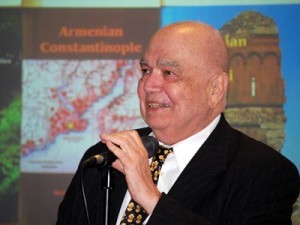Marine Vardanyan
Staff Writer

Photo: Erica Magarian
When we think of Armenia today, we visualize the small landlocked nation bordered by Iran, Turkey, Georgia, and Azerbaijan. Although modern-day Armenia may be smaller than the state of Maryland, it was once a great empire, stretching from the Caspian Sea to the Mediterranean, under the rule of King Tigran the Great. Throughout history the Armenian nation has significantly shrunk in size and the Armenian people have lost much of their land, yet even though much of the original land has been lost, the historical presence of the Armenian people has remained.
On Thursday evening, April 19, Dr. Richard Hovannisian, Professor Emeritus of Modern Armenian History at UCLA, presented a talk on “The Changing Landscape of Historic Western Armenia: Reflections on a Journey Into the Past.”
Dr. Hovannisian’s presentation was part of the Armenian Studies Program Spring Lecture Series. Armenian Studies Program Coordinator Barlow Der Mugrdechian introduced Dr. Hovannisian to the audience.
Western Armenia was the formerly Armenian-inhabited area of the Ottoman Empire, where much of the Armenian population was eliminated during the Armenian Genocide. Dr. Hovannisian displayed photographs from his travels to Erzerum, Kharpert, Van, Moush, Malatya, Bazmashen, Kars and many other formerly Armenian-inhabited areas, most of which are now heavily populated with Kurds. Visiting the land where less than a 100 years ago generations of Armenians lived, Dr. Hovannisian stated that he was originally hesitant to take the journey in fear of being hurt by seeing the ruin and devastation.
Dr. Hovannisian has visited Turkey several times, with the most recent trip being last year to the region of Ani and Samsun.
“It was very emotional and difficult because of the contradictions,” said Dr. Hovannisian. Although most of the soil that belonged to Armenians is now occupied by the Kurds and Turks, the Armenians have not been forgotten. During his trip, a Turkish man invited Dr. Hovannisian to witness a play by the satirist Hagop Baronian, a Kurd showed him photographs with Armenian writings of old Kharpert, and many others spoke to Dr. Hovannisian about the Armenians who once lived amongst them or the very few who still do.
Along with those experiences, Dr. Hovannisian also witnessed the once beautiful Armenian churches, most of which were damaged or destroyed. Those that were not dynamited by the Turks were either converted to mosques, stables, barns, or parking lots. Dr. Hovannisian commented that the only way to survive the trip was to “put myself out of my own body.”
Many members of the audience observed photographs of the villages from where they, their parents, or grandparents came from. For many Armenians in the San Joaquin Valley, Western Armenia brought to them more feelings of familiarity than what they find in modern day Armenia.
Dr. Hovannisian stated that the “sound, taste, music, motion, and dance” witnessed on his journey was very familiar. His photographs and stories held aspects of humor and sorrow, and those members of the audience who wished to learn more about his journey to Western Armenia were eager to purchase one of the volumes from Dr. Hovannisian’s series of conferences on “Historic Armenian Cities and Provinces.”
The lecture by Dr. Richard Hovannisian gave an overview of what once was, and what has been lost. It was enlightening for all who attended.
 Hye Sharzhoom Armenian Action
Hye Sharzhoom Armenian Action